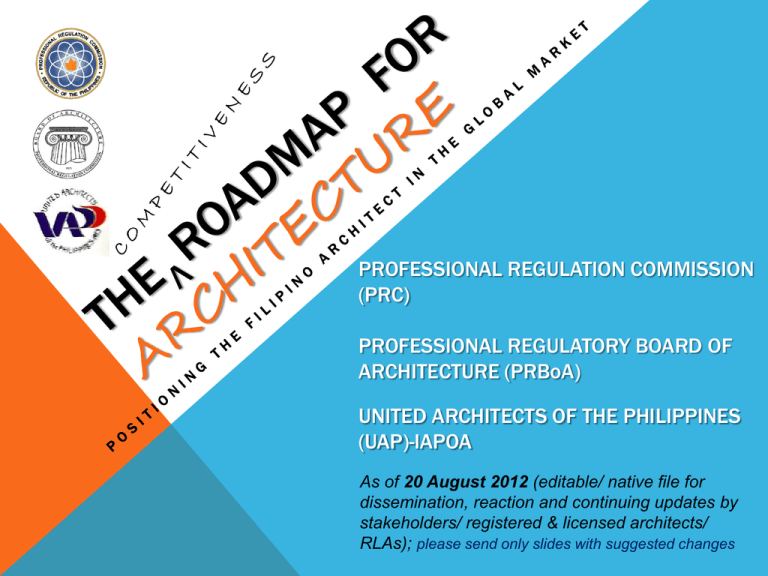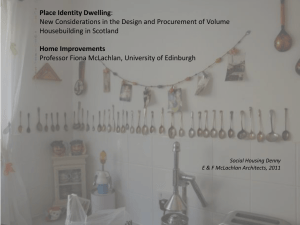THE ROADMAP FOR ARCHITECTURE - Reconstituted Professional
advertisement

PROFESSIONAL REGULATION COMMISSION (PRC) PROFESSIONAL REGULATORY BOARD OF ARCHITECTURE (PRBoA) UNITED ARCHITECTS OF THE PHILIPPINES (UAP)-IAPOA As of 20 August 2012 (editable/ native file for dissemination, reaction and continuing updates by stakeholders/ registered & licensed architects/ RLAs); please send only slides with suggested changes • An evidence-based directional tool designed to give forward-looking strategic guidance by highlighting fundamental features of the surrounding landscape. • A map which plots the way forward from where we are now to where we want to get. It keeps us on track to ensure that we do not get lost on route. • It highlights obstacles and proposes ways of getting around them. ROADMAP • It is useful when we need to respond to rapid changes resulting from either the business environment or a new technology. • Information gaps can be addressed through a “Roadmap process”. • It becomes a vital advocacy tool in getting the help we need whether it’s from the government or from the private sector. WHY DO WE NEED A ROADMAP ? A Competitiveness Roadmap is one that takes us from wherever we stand now, on the competitiveness grid, to a position where we can offer front-line Architectural services in the global market. COMPETITIVENESS ROADMAP • Under the ASEAN Mutual Recognition Arrangement (MRA), new opportunities are being opened up for us, and new competitive threats are also emerging. • We must quickly get into a position to assess: • How our interests are being affected • Where our strengths and weakness lie • Where opportunities can be maximized • How defensive our posture needs to be and why • How to resolve domestic issues fast (education system, legal and regulatory regimes which prevent the full implementation of our law) DO WE REALLY NEED A ROADMAP ? YES ! • WHERE ARE WE ON THE MAP ? • HOW COMPETITIVE ARE WE ? • DO WE HAVE FILIPINO ARCHITECTS IN THE INTERNATIONAL MARKET? • ARE WE COMPETITIVE IN THE DOMESTIC MARKET? • ARCHITECTURE is possibly one of the oldest recognized professions (up to 5,000 years of recorded architectural history); the word Architect comes from the word Arkitekton which means master builder in ancient Greece • First Philippine tertiary school of architecture was established in 1901 • First Philippine architect registered in 1921 • Joint professional regulatory law (PRL) for Architecture and Civil Engineering (CE) in the Philippines until June 1950 HOW COMPETITIVE ARE WE? HISTORICAL FACTS (1) • Organic architecture law was passed in June 1950, limiting the practice of architecture to registered architects (simultaneously with organic CE law). Simultaneous amendments were made in June 1956 • Repeal architecture law (R.A. No. 9266) was passed in 2004 limiting the preparation, signing and sealing of all architectural documents for all buildings on Philippine soil to registered and licensed architects (RLAs) • 2012 - Almost 30,000 registered architects (RAs) • 1 integrated accredited professional organization (APO) & 3 Other Associations of Architects; 15 foreign APO chapters (USA, Canada, SG, Middle East & North Africa/ MENA region) HOW COMPETITIVE ARE WE? HISTORICAL FACTS (2) EDUCATION SYSTEM / CURRICULUM • +/-80 schools offering the BS Architecture program; • Almost 12,000 enrolled in BS Architecture Program (all levels); • At least 3 CHED Centers of Excellence for Architecture Education; • Performance of schools in licensure examinations as indicator of the quality of education and educators. Some schools have 0 to 1 passer; • Many graduates lack skills in various forms of communication; • Need to further improve architectural instructor qualifications; need more opportunities for practitioners to teach; • Curriculum lacks training in business and construction as evidenced by administrative cases filed at the PRC; • Need to harmonize (perhaps standardize?) teaching methods among schools in the Philippines; and • Need to harmonize the curriculum across the ASEAN member states. HOW COMPETITIVE ARE WE? MEASURABLE INDICATORS OF COMPETITIVENESS (1) LICENSURE EXAMINATION FOR ARCHITECTS • Commenced Foreign Licensure Examinations for Architects (FLEAs) in 2007 for Filipino architecture graduates employed overseas, particularly in the Middle East; • Full computerization of the LEA in 2009; • About 4,000 took the licensure examination for architects (LEA) annually for the last 3 years (2010 to 2012); • Average 50% national passing rate for the last 3 years; • reformat of LEA with 100% focus on buildings, building environments and grounds helped to increase LEA passing rate as well as the relevant competencies of entry-level RLAs; and • Verbal communication and drafting skillsets not tested in the LEA. HOW COMPETITIVE ARE WE? MEASURABLE INDICATORS OF COMPETITIVENESS (2) CONTINUING PROFESSIONAL EDUCATION • About 15 CPE Providers and 20 CPE programs; • CPE programs not yet integrated, not yet designed for specialization; & • CPE is not a requirement for renewal of professional ID card. GREATER AWARENESS by PUBLIC & PRIVATE SECTORS • R.A. No. 9266 (The Architecture Act of 2004) – through various information dissemination platforms , including PRBoA website with more than 1 million visits as of mid 2012; • Physical planning, building, environmental and professional laws – by RLAs; and • P.D. No. 1096 (the 1977 National Building Code of the Philippines/ NBCP) – by RLAs and allied regulated professionals. HOW COMPETITIVE ARE WE? MEASURABLE INDICATORS OF COMPETITIVENESS (3) ARE THERE ENOUGH ARCHITECTS TO MEET THE DOMESTIC DEMANDS? Almost 13,000 registered & licensed architects (RLAs); About 6,000 RLAs in active local professional practice (general practice and various specializations, mainly covering private buildings/ spaces ); About 500 architectural firms operating locally; less than 15 architectural firms take part in public procurement for architectural consulting services; About 35 registered architectural firm (RAFs) ; and Main MARKET for architectural services is the domestic private sector. And yet a DOLE report says that there is a shortage of Architects with certain specializations. The demand for other professional categories are not being met. HOW COMPETITIVE ARE WE? DOMESTIC MARKET CONTEXT SIGNIFICANT PRESENCE OF FILIPINOS IN ARCHITECTURAL FIRMS OVERSEAS About 5,000 RLAs and architectural graduates are employed overseas worldwide PRESENCE OF FILIPINO ARCHITECTURAL FIRMS OVERSEAS NOT SIGNIFICANT About 40 APEC Architects; and Soon to register ASEAN Architects. But APEC and ASEAN agreements cannot guarantee the hiring of Filipino architectural firms by international clients. HOW COMPETITIVE ARE WE? INTERNATIONAL MARKET CONTEXT LOCAL DEVELOPERS CONTINUE TO HIRE FOREIGN ARCHITECTS TO UNDERTAKE < THE CONCEPTUAL DESIGN OF > PROJECTS ON PHILIPPINE SOIL PRBoA has commenced the registration of Foreign Architects (FAs) with projects on Philippine soil in 2007; Foreign architects usually create the concept design yet take the lion’s share of the professional fee; and Some collaborating Filipino architects merely act as “rubber stamp” instead of taking advantage of the transfer of technology. HOW COMPETITIVE ARE WE? FOREIGN ARCHITECTS (FA) IN THE PHILIPPINES Existence of a strong professional regulatory law (RA No. 9266); Membership of the APO to international architectural organizations UIA and ARCASIA for benchmarking of professional standards Linkages of the APO to institutions for architectural education; Government support for benchmarking of professional laws and standards, licensing and registration of professionals in the ASEAN Region; Government support for benchmarking of architectural curriculum in the ASEAN Region; and English proficiency. HOW COMPETITIVE ARE WE? ( + ) FACTORS AFFECTING COMPETITIVENESS Weak mechanism for provision of quality continuing professional education; Unresolved domestic issues on supposed overlapping scope of work with other regulated professions (which does not exist, not countenanced under present laws); Inefficiencies in the legal and regulatory framework of the profession; Lack of Government support in the implementation of the professional regulatory law (PRL) R.A. No. 9266, the Architecture Act of 2004; and Domestic practice orientation coupled with lack of exposure in international markets, technologies and trends. HOW COMPETITIVE ARE WE? ( - ) FACTORS AFFECTING COMPETITIVENESS • ESTABLISH GOALS • SET SHORT, MEDIUM, AND LONG-TERM TARGETS • SET MILESTONES • AMBITIOUS OR REALISTIC? BORDERLESS PRACTICE Level of Competitiveness 10 3 DOMESTIC IMPEDIMENTS 0 2012 2015 ASEAN MRA Regional 2020 WTO GATS Global ROADMAP FOR ARCHITECTURE ( A MODEL) BORDERLESS PRACTICE Level of Competitiveness 10 3 DOMESTIC IMPEDIMENTS 0 2012 2015 ASEAN MRA Regional 2020 WTO GATS Global ROADMAP FOR ARCHITECTURE ( A MODEL) THESE DOMESTIC IMPEDIMENTS MUST BE RESOLVED SO THAT THE FILIPINO ARCHITECT CAN FOCUS ON BEING GLOBALLY COMPETITIVE ILLEGAL PRACTICE BY UNREGISTERED PERSONS AND BY OTHER Registered & Licensed Professionals (RLPs) LACK OF GOVERNMENT SUPPORT APPARENT FLAWS IN INTERPRETATION, IMPLEMENTATION AND ENFORCEMENT OF THE LAW DOMESTIC IMPEDIMENTS IF THE DOMESTIC IMPEDIMENTS TO THE PRACTICE OF ARCHITECTS IN THE PHILIPPINES ARE NOT FULLY RESOLVED BY THE GOVERNMENT, IT SHALL BE VERY DIFFICULT FOR PHILIPPINE ARCHITECTS TO BE GLOBALLY COMPETITIVE RESOLVE DOMESTIC IMPEDIMENTS FIRST • INVOLVE ALL STAKEHOLDERS • IDENTIFY FACTORS RELEVANT TO OUR COMPETITIVENESS • GATHER DATA TO CONFIRM WHERE WE CURRENTLY STAND ON THE MAP AND TO ASSESS HOW ROUGH THE ROAD WILL BE • CONDUCT SCOPING STUDY • IDENTIFY INFORMATION GAPS • DESIGN SURVEY INSTRUMENT TO HELP GATHER INFORMATION UAP Commission on Internal Affairs prepares survey form, sends to Chapter presidents Members fill out forms, chapter president forwards forms to UAP Secretariat together with payment for annual membership UAP Secretariat collates and encodes information, submits to NEVP Personal data, educational background, type and size of practice, specialization, professional experience local and international, type of projects, computer application, income, affiliations, COMPREHENSIVE DATA BASE PROCESS • DEFINE PROJECTS AND ACTIVITIES TO INCREASE COMPETITIVENESS • ALLOCATE RESPONSIBILITIES • SET DEADLINES • SET UP MONITORING PROCESSES • ESTABLISH POLICY FRAMEWORKS FOR ARCHITECTURAL SERVICES • ESTABLISH NECESSARY LINKAGES WITH GOVERNMENT AND INTERNATIONAL AGENCIES Architecture Code of the Philippines (ACP) as a new law Repeal of the National Building Code of the Philippines/ NBCP (P.D. No. 1096) Full professionalization of the position of LGU Building Official (BO) LEGISLATIVE AGENDA (1) Support for the law prescribing a Life Sentence for Erring Building Officials (already filed at the Senate) Creation of the Department of Housing, Settlements and Urban Development which shall have exclusive jurisdiction over all buildings and all vertical components of the built environment LEGISLATIVE AGENDA (2) Non-RLAs/ Unregistered Persons (including other registered & licensed professionals/RLPs) UAP-IAPOA COMMISSION ON PROFESSIONAL PRACTICE Foreign Architects (FAs) without Special Temporary Permit (STP) CAMPAIGN AGAINST ILLEGAL PRACTITIONERS UAP TO ACCREDIT ARCHITECTS WHO INTEND TO SIGN AS MENTOR IN THE LOGBOOK FOR DIVERSIFIED ARCHITECTURAL EXPERIENCE ARCHITECT MENTORS UAP SCHOOLS UAP and SCHOOLS TO COORDINATE THROUGH CODHASP MENTORSHIP PROGRAM SCHOOLS TO VISIT AND ACCREDIT ARCHITECTURAL OFFICES FOR STUDENTS WHO WISH TO UNDERTAKE DIVERSIFIED ARCHITECTURAL EXPERIENCE DURING 3rd – 5th YEAR IN PREPARATION FOR THE LICENSURE EXAMINATION LGU INFORMATION CAMPAIGN on the procurement Law (covering Consulting Services) OFFER PROFESSIONAL ASSISTANCE TO LGUs UAP COMM ON GOV’T & EXTERNAL R.A. No. 9184 (Govt Procurement Reform Act of 2003/ GPRA) AFFAIRS BAC INVOLVEMENT IN GOVERNMENT PROJECTS MEMBERSHIP TO BIDS AND AWARDS COMMITTEE OF GOV’T AGENCIES IDENTIFY ARCHITECTS CONDUCT FORUM DISCUSSIONS WITH ARCHITECTS DOING COLLABORATIVE OR INDEPENDENT PRACTICE OVERSEAS LINK W GOV’T AGENCIES TO PARTICIPATE IN INTERNATIONAL EXPOSITIONS LINK W NCCA FOR PUBLICATION OF COFFEE TABLE BOOKS ON ICONS IN FILIPINO ARCHITECTURE FOR DISTRIBUTION TO COMPANIES OVERSEAS RE-BRANDING THE FILIPINO ARCHITECT ENCOURAGE MEMBERS TO PARTICIPATE IN INTERNATIONAL COMPETITIONS MARKETING PORTAL FOR THE FILIPINO ARCHITECTS AND ARCHITECTURAL FIRMS FOR USE BY PROSPECTIVE DOMESTIC AND INTERNATIONAL CLIENTS SPECIALIZATION TECHNOLOGY, CAD / BIM APPLICATION BUILDING LAWS: LOCAL & GLOBAL CPE PROGRAM ADVANCED & INTERNATIONAL PRACTICES PREPAREDNESS FOR BORDERLESS PRACTICE LOCAL Architecture schools distinct and headed only by Architects; Introduce construction & management courses to curriculum; Establish architecture education accreditation system; Specialized Practices Certification Program; Masters Program in Advanced & International Practices in Arch; More CHED ETEEAP Partner Schools for CPE. ASEAN Collaboration among deans & heads of architectural schools among ASEAN member states to harmonize curriculum EDUCATION GRAPHIC EDITION OF THE NATIONAL BUILDING CODE (Proposed Research Grant from the NCCA) GOVERNMENT GRANTS PRO-ACTIVE PROGRAMS TO MONITOR THE IMPLEMENTATION AND ENFORCEMENT OF THE LAWS ON ARCHITECTURE, PHYSICAL PLANNING AND BUILDINGS COMPLIANCE MONITORING • DISTRIBUTE ROADMAP TO ALL STAKEHOLDERS • ROADSHOWS • ROUNDTABLE DISCUSSIONS • PUBLIC – PRIVATE NETWORKING • CREATE AWARENES AMONG ARCHITECTURAL GRADUATES AND STUDENTS NATIONWIDE INFORMATION CAMPAIGN TO EMPHASIZE THE NEED TO INCREASE DOMESTIC & INTERNATIONAL COMPETITIVENESS PROMOTE REGISTRATION OF ASEAN & APEC ARCHITECTS AND TO CORRECT MISCONCEPTIONS REGARDING BORDERLESS PRACTICE BE PREPARED FOR 2015 Thank You. Let us all make things happen for a better future for all Philippine registered and licensed architects (RLAs)






